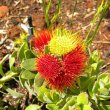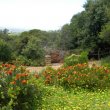Leucospermum oleifolium
| Botanical Name | Leucospermum oleifolium |
|||||||||||
| Family | Proteaceae - The Protea family
|
|||||||||||
| Pronunciation | loo-koh-SPER-mum oh-lee-ih-FOH-lee-um |
|||||||||||
| Common Name(s) |
English: Overberg pincushion
|
|||||||||||
| Plant Group |
|
|||||||||||
| Plant Size |
|
|||||||||||
| Position |
|
|||||||||||
| General Information |
|
|||||||||||
| Specific Information | Leucospermum oleifolium is an erect, reasonably small, rounded shrub, growing up to 1 m tall and spreading about 1.5 m in diameter. It has a single main stem and forms a compact bush. The broad, silvery-grey leaves are an attractive foil for the brightly coloured flowers. They have a long flowering period and are much visited by a variety of birds for both the insects on the flowers as well as for the abundant nectar they produce. The nut-like seeds are collected by ants, stored in the soil and germinate only after a fire has killed the mature plants. They are hardy to USDA zone 9 and are best suited to a winter rainfall climate. This attractive shrub belongs to the group of leucospermums known as the 'Flat Pincushions' as they do not curl at the tips. Leucospermum oleifolium is a highly variable shrub, which is borne out by the fact that it was previously classified as 8 seperate species. |
|||||||||||
| Ad Break | ||||||||||||
| Flowers | ||||||||||||
| Description | turban-shaped, up to 40 mm in diameter, at the end of branches in clusters of up to five flowers, changing in colour as they age from yellow to orange to crimson |
|||||||||||
| Season |
|
|||||||||||
| Colour |
|
|||||||||||
| Growth Rate |
|
|||||||||||
| Plant Uses |
|
|||||||||||
| Distribution and Habitat | in the South-Western Cape, from the Du Toit's Kloof to the Caledon area of the Swartberg Mountains, in extensive, dense stands in some areas and in others as scattered individuals |
|||||||||||
| Planting Suggestions | This can be a sensitive plant unless it is grown in specific conditions. Bear its natural growing conditions in mind and plant Leucospermum oleifolium in a slightly acid, sandy, light soil that drains well, in a sunny, airy position. Water regularly for the first two years but beware of over watering, which can cause root rot. Do not use animal manure or fertiliser. Some well-rotted compost can be mixed into the soil before planting in a hole that is just a little bigger than the root ball. As with all members of the Protea family, they are prone to a root fungus so ensure that the roots, (which form a network close to the soil surface) are never disturbed. Spread a layer of mulch around the plant to demarcate the area. Mulch will also add nutrients to the soil, keep the soil cool, lessen the growth of weeds and retain moisture. Leucospermum oleifolium can be propagated by seed or from cuttings. Visit http://www.plantzafrica.com for more information in this regard. |
|||||||||||
| Medicinal Uses | No data found. |
|||||||||||
| Ad Break | ||||||||||||








Comments
watering
Hi,
I have recently purchased a Leucospermum cuneiforme in the UK. The plant was in gloriuos flower but the flowers have gone over now. I have watered it once with rain water shrtly after purchase approx 2 weeks ago. The plant stays in our conservatory, and with the hot weather the conservatory gets very warm too.I check the plant every day, and today it looked unwell, the leaves were drooping slightly so I gave it another sprinkling of rain water. My problem is that I don't know how often to water the plant and have erred on the side of hardly watering it. I don'twant to loose this plant, could you offer any advise please?
kind regards,
Ann Holmes
Ailing Leucospermum cuneiforme
Hi Ann
I've given your query some thought and to be of use, I need some specific information.
Has the plant been recently re-potted?
What is the humidity level in the conservatory?
Is it in a clay, cement or plastic container?
How is the conservatory irrigated, other than by hand?
Sorry I've taken so long to reply. I'll write back as soon as I get your answers.
Kind regards
Lorraine
leucospermum
Hi Lorraine,
Thank you for getting back to me.I will answer the above questions as best I can.
The plant was bought from a nursery at the begining of April so I do not know how long the plant has been in the same pot.
There is little if no humidity in the conservatory.
The plant is in a plastic pot which measures approx.150x150mm.
The conservatory is not irrigated, watering is done by hand only.
I have brought the plant into the lounge which is much cooler and it has been placed by glass doors which lead into the conservatory.
The leaves are very dry and leathery, I do not know if this is normal and I do so want to understand this plant and help it to survive.
Thankyou for any advise and help you might be able to give me.
Kind regards Ann
Sickly plant
Hi Ann
Thanks for the information. The first reason for wilting is when a plant has transpired too rapidly and this is easily remedied by the addition of water after which the plant perks up. From your description, this is not appear to be your problem, or the plant would have recovered by now.
The two other reasons for wilting leaves both have rather more dire outcomes. A plant may wilt as a result of loss of water past the point of recovery, or the wilt may be the result of a disease organism that reduces or even prevents the uptake of water.
On reading that the plant is in a pot only 15 cm by 15cm (is it really that small?) rings alarm bells. That seems way too small for a Leucospermum of flowering age. It is quite possible that you may indeed have erred too much on the dry side. The protea family does cope with dry soil but it is able to do so only because it has a large network of surface roots spreading all round the shrub, just below the surface of the ground. These roots are fed by every tiny bit of moisture, even heavy dew. In a container the plant cannot develop these surface roots so must get more water artificially. The container should be quite large and deep and hold at least30 - 40 liters of a good protea soil mixture.
I have noticed that in many of our nursery 'factories' plants are sold in full bloom for instant colour etc, but are not potted so as to live past the blooming period. Kind of like a living bunch of flowers. Ideally the plant should immediately have been transplanted into a larger container, but as it was already in flower, you could not have done this anyway. I really do feel that the supplier should have sold this plant in a much larger container.
If your plant is still alive, there is the possibility it may yet recover. If it does, I would suggest it be re-potted as soon as it seems strong enough to cope with the move. Make sure the roots are not in any way disturbed when you do this. Just ease the plant out of the container and into its new container, carefully settling the whole ball firmly into the soil.
If the plant has contracted a wilt disease there is little you can do and it is almost certain the plant will die. This is usually a sudden death within two or three days.
The leaves of the protea family are usually very leathery but not dry or yellowing. At a nursery or wholesaler, plants are kept in a very stable, artificial environment, often forced into fast growth and flowering for a quick turn-over of stock. Once the plant is out of this environment its chances of survival are reduced, even more so if the plant is not supplied with the soil nutrients and container it actually needs - which would cost them money. (I do not have much faith in the system, as you can see). Leucospermums also like some direct sun and are very partial to windy conditions and low humidity.
My apologies for this lengthy reply. I hope you are able to save your plant, but if not you will know what to do next time. Better to obtain one well before the next flowering season.
Kind regards
Lorraine
Hi Lorraine,
Hi Lorraine,
Thank you so much for all the information, it is very much appreciated, and I will do my very best for the plant as I try to do for all my plants. I meant to mention to you that I also have a very healthy Protea and two Plumerias (Frangipani) also two Strelizia's which flower freely. Thank you so very much once again.
Kind regards,
Ann.
Discuss this plant
Share knowledge, ask a question or give an experience.